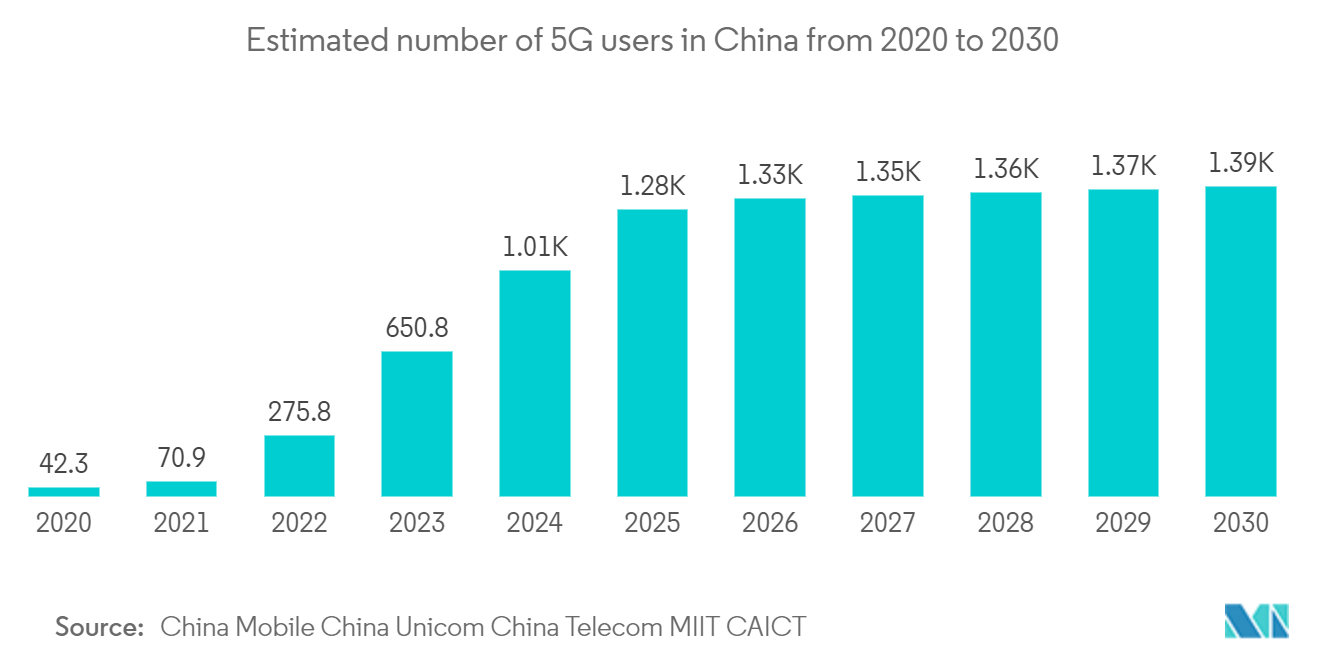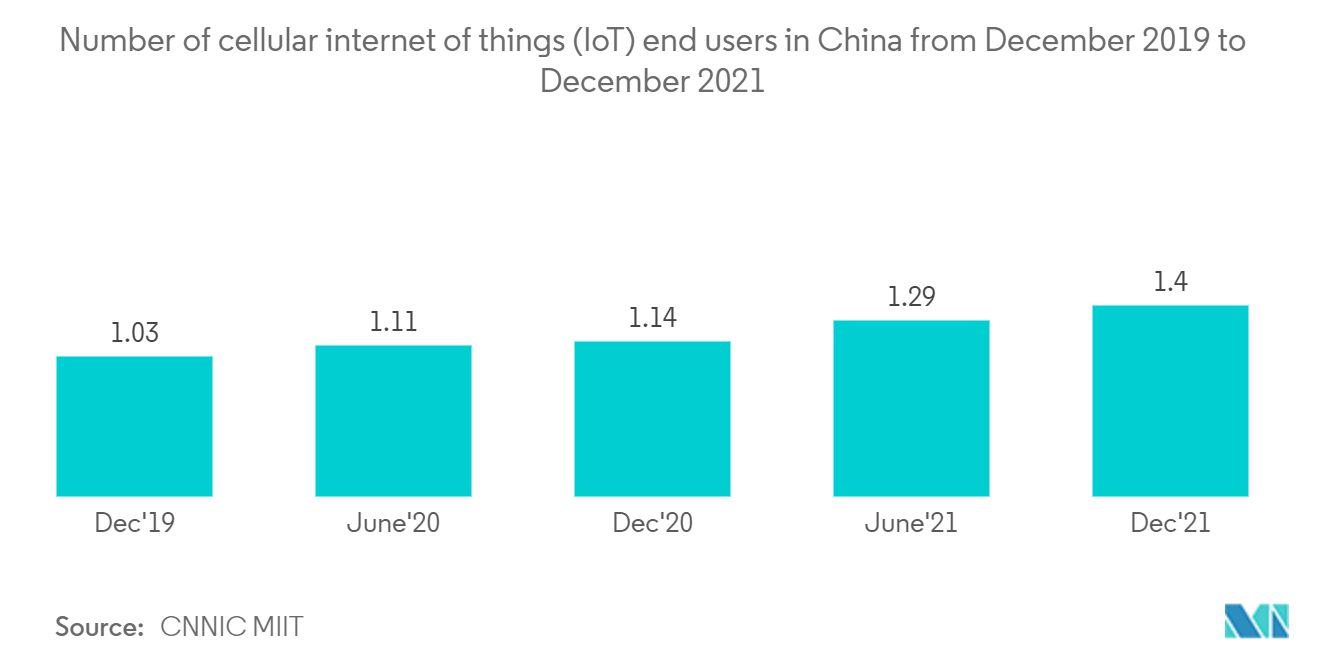Market Trends of China Telecom Industry
This section covers the major market trends shaping the China Telecom Market according to our research experts:
Stellar performance of 5G would trigger wireless segment growth
- The previous year was crucial for 5G's first success and further development. Globally, 5G is steadily expanding to become the fastest-commercializing mobile technology. China is now the country with the most 5G connections and base stations globally. Due to the implementation of 5G, new players can now enhance the telecom ecosystem. The most recent 5G launch shows how the number of participants is increasing, whether they are successful or not.
- On October 31, 2019, China Telecom, China Unicom, and China Mobile began 5G services. As per an Electronics Media report, compared to the United States, which has 5G in 296 cities, China has 356 more towns covered by 5G services than it has. By the end of last year, China had two million 5G base stations. China Broadnet's 5G service has gained state-wide coverage only a few months after its initial introduction. In September last year, the fourth-largest operator in the nation formally debuted commercial 5G network services in the Qinghai Province in northwest China and the Xizang Autonomous Region in southwest China, expanding its 5G coverage to all 31 provinces.
- Compared to its competitors, China Mobile earned 160MHz in the 2.6GHz band and 100MHz in the 4.9GHz round, while competitor carriers China Telecom and China Unicom each received 100MHz in the 3.5GHz game. Early last year, China Broadnet announced a special discount promotion that will save consumers 40% when purchasing 5G bundles, bringing the operator's 5G coverage roll-out ahead of the anticipated November launch date.
- In a post-pandemic future, digital connections and services are crucial for allowing both innovative business models and better consumer experiences. Authorities in China have moved to develop enabling regulations for constructing cost-effective infrastructure because they recognize the possibilities digital technology can offer society. In January last year, the MIIT report disclosed that operators in mainland China had deployed more than 1.4 million 5G base stations. Since then, the MIIT has set an ambitious goal to treble the number of 5G base stations to 3.64 million by the end of 2025.

Demand for new digital services
- To further the development of digital China, new and innovative technological advancements in fields like software, semiconductors, and operating systems are required. Cloud-network integration has become the key component of digital information infrastructure. To progress the Digital China program, the fifth Digital China Summit, hosted online and offline over two days, focused on new innovations-driven developments and digitalization-led landscapes. It also had a display of the most recent technological developments and items. As the country's largest telecom provider to create a reliable digital telecom infrastructure for a digital China, China Telecom will intensify efforts to promote the convergence of cloud computing and telecom network technologies.
- According to the Ericsson IoT Accelerator report, with the "One Belt, One Road" policy in mind, China Telecom has developed the connection management platform CTWING to accelerate the deployment of IoT products and services deployment. Through collaborations, China Telecom helps businesses to implement, regulate, and grow IoT device management. The managed connection service provided by China Telecom is integrated with the business operations of enterprise clients using this solution to produce highly dependable IoT solutions.
- Ericsson has worked as a dependable, established technology partner with China Telecom for many years. Due to its extensive experience in the worldwide IoT market, Ericsson was chosen as the service provider's partner in IIoT. Its IoT Accelerator platform offers business clients dependable connections based on service-level agreements and a unified perspective of devices and access networks, supporting China Telecom's international IoT aspirations.
- The cloud has evolved into a key growth engine for Chinese telecoms, marking it another point of distinction from other markets. The three telcos reported combined cloud revenues of 70 billion Chinese yuan (USD 10.1 billion) in their interim results from August 2022. China Telecom saw a growth of 101% to 28 billion yuan (USD 3.9 billion), China Mobile saw an increase of 104% to 23 billion yuan (USD 3.2 billion), and China Unicom saw a growth of 143% to 19 billion yuan (USD 2.6 billion).
- According to government research organization CAICT, the public cloud accounted for three-fifths of the 301-billion-yuan (USD 42 billion) industry in the previous year, with the Chinese cloud market growing by 48%. As per an IDC report, the government cloud industry is one of the markets with the most significant growth potential, which is expected to develop gradually over the next three to five years and reach USD 6 billion in revenue in the previous year, an increase of 21%.
- As per a study by China Internet Network Information Center (CNNIC), China had more than one billion Internet users as of June last year; the enormous scale has accelerated the creation of new digital infrastructure, facilitated domestic circulation, and enhanced digital government services. These factors have all contributed to the high-quality development of China's economy. The flexible work paradigm exemplified by the online office will continue to be developed in China as digital business transformation continues. Online document collaborative editing and online video/teleconferencing usage were both 23.8% as of June last year, up 1.0 and 2.6 percentage points, respectively, from December 2020. As reported by CNNIN, online document collaborative editing and online video/teleconferencing usage were both 23.8% as of June last year, up 1.0 and 2.6 percentage points, respectively, from December 2020.


